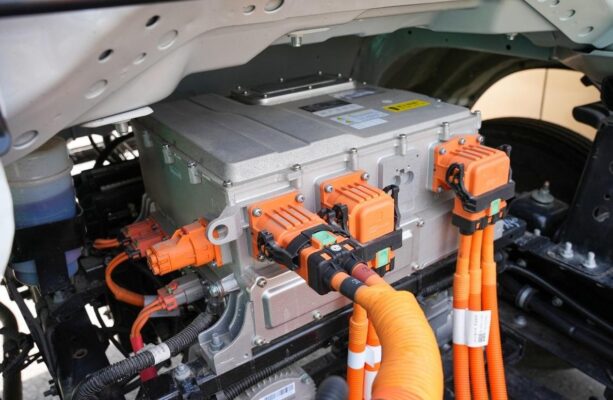Electric Truck Knowledge
How much do you know about the maintenance of the steering system
Posted on by Electric Trucks
The steering system is of paramount importance for trucks, yet not all truck drivers are well-versed in its daily maintenance. Let’s delve deeper into this crucial aspect and explore it in detail.
The oil level in the steering system’s oil tank needs vigilant monitoring. When the engine is operational, it’s essential for the oil level to fall within the prescribed range marked by the upper and lower limits on the dipstick. A level that is too low can lead to a failure of the steering system’s power assistance, compromising the vehicle’s handling and safety.
Visual inspections are equally vital. The lubrication of the mechanical connectors within the steering system should be checked regularly to ensure smooth operation and prevent premature wear. Opening the steering oil reservoir allows for an assessment of the oil level, as well as the cleanliness of the steering oil and the filter element. Any dirt or debris in the oil or a clogged filter can adversely affect the performance of the steering system.
Check our Featured products!
Checking for damage or deformation in the steering tie rod and pressure bearing is critical. These components play a significant role in the stability and accuracy of the steering. Even minor damage can lead to steering problems and potential safety hazards on the road.
Starting the engine and gently moving the steering wheel left and right helps identify any excessive clearance or emptiness in the mechanical connection. A noticeable looseness or play could indicate worn-out parts that require immediate attention.
Jacking up the steering axle and manipulating the steering wheel up and down allows for a check of the clearance in the steering knuckle part. Excessive clearance here can indicate wear and potential failure points.
It’s also essential to start the engine and inspect the entire steering hydraulic system for any oil leaks. Even a small leak can escalate into a significant problem if left unchecked, potentially leading to a loss of steering control.
Now, let’s focus on the operating specifications for replacing the oil of the steering system. Before draining the oil, it’s imperative to clean the area around the oil tank and the oil pipe joints to prevent dirt and debris from entering the system.
Jacking up the steering axle to lift the tires off the ground is the first step. Then, whether it’s a single or double steering axle, the three joints of the steering gear should be disassembled. Rotating the steering wheel to the limit positions left and right ensures the complete drainage of the old steering oil.
After reinstalling the oil pipe joint and confirming a secure connection, it’s time to refill with ATF steering hydraulic oil. The filling process continues until the oil level reaches the top of the tank and stabilizes.
Starting the engine in an idle state without turning the steering wheel initially allows the system to stabilize. Be vigilant as the oil level may drop rapidly, and topping up in a timely manner prevents air from entering the system.

When the oil level remains stable, turning the steering wheel left and right helps confirm that it is at the upper mark. Finally, fastening the dipstick of the steering oil tank and stopping the engine complete the oil replacement process.
Some precautions for the steering system oil are worth noting. The drained oil must not be reused, and new and old oils should never be mixed to maintain the integrity and performance of the system. Additionally, running the engine for an extended period during this process can cause damage to the power steering pump.
For the first maintenance of the steering system, typically within 2000 to 5000 kilometers, several specific items need inspection. Lubricating the front steering kingpin and the brake adjustment arm helps ensure smooth operation and reduces friction. Depending on the tire condition, checking and adjusting the toe-in of the front wheels and the tightness of the wheels is essential for optimal handling and tire wear.
Inspecting for loose clamp bolts and ball joints on the steering tie rod and longitudinal tie rod is crucial to maintaining steering stability. Any looseness can result in inaccurate steering and potential safety risks.
Checking for looseness in the vertical arm of the steering gear and the middle vertical arm of the double steering is important to ensure precise steering control. Abnormal wear in the steering linkage should also be identified and addressed promptly.
The oil level of the steering oil should be checked for both normalcy and cleanliness. If necessary, the filter element should be cleaned or replaced. Inspecting the steering power assistance pipeline for aging and oil leaks helps prevent potential failures. Ensuring there is no interference or wear in the oil and gas pipelines is equally important.
Checking the clearance between the brake shoe and the brake drum or the wear amount of the brake pad of the disc brake is vital for effective braking performance. Confirming that the brake returns to its position normally after application is essential for safe driving.

In addition to these routine maintenance and inspection tasks, it’s advisable for truck drivers to be attuned to any unusual sounds, vibrations, or handling characteristics when driving. Even subtle changes in the steering response can be an early indication of a developing issue. Regular training and staying updated on the latest maintenance best practices for the specific make and model of the truck can also enhance the longevity and reliability of the steering system.
For instance, in extreme weather conditions such as very cold or very hot temperatures, the steering system may be subjected to additional stress. Cold weather can cause the oil to thicken, affecting its flow and performance, while hot weather can accelerate the deterioration of rubber components. Adapting the maintenance schedule and using appropriate lubricants and fluids for the prevailing conditions can go a long way in preventing problems.
Furthermore, maintaining a detailed maintenance log of all inspections, repairs, and component replacements related to the steering system can provide valuable insights over time. It helps identify patterns, predict potential issues, and ensures that any warranties or service agreements are adhered to.
In conclusion, the maintenance of the steering system is not a one-time task but an ongoing commitment. By following these guidelines, conducting regular inspections, and addressing issues promptly, truck drivers can ensure the safety and reliability of their vehicles, minimizing the risk of breakdowns and accidents on the road. A well-maintained steering system is not only a matter of convenience but a lifeline on the journey.